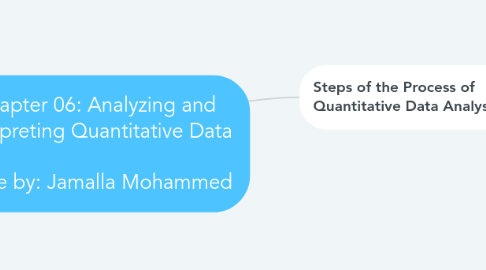
1. Steps of the Process of Quantitative Data Analysis
1.1. Preparing the data for analysis
1.1.1. How Do You Prepare the Data for Analysis?
1.1.1.1. Score the Data
1.1.1.1.1. Assign numeric codes to responses
1.1.1.1.2. Create a codebook using information from instruments, when possible
1.1.1.2. Determine the Types of Scores to Analyze
1.1.1.2.1. Single item
1.1.1.2.2. Summed scores
1.1.1.2.3. Difference scores
1.1.1.3. Select a Statistical Program
1.1.1.3.1. Find documentation or online tutorials
1.1.1.3.2. Ease of use is important
1.1.1.3.3. Ensure the program includes statistics, graphs, and tables you need to use
1.1.1.3.4. Look at amount and type of data accepted
1.1.1.3.5. Consider cost and what is used on campus
1.1.1.3.6. Examples:
1.1.1.4. Input Data
1.1.1.4.1. Transfer the data from the responses on instruments to a computer file for analysis
1.1.1.4.2. Similar to a spreadsheet
1.1.1.4.3. Use a codebook to assign a number to categorical data.
1.1.1.5. Clean and Account for Missing Data
1.1.1.5.1. Identify scores outside of the accepted range (Errors)
1.1.1.5.2. Assess the database for missing data and determine how to handle
1.1.1.5.3. Process of inspecting the data for scores (or values) that are outside the accepted range
1.1.1.5.4. To identify errors
1.1.1.5.5. Missing in the database because participants do not supply them
1.1.1.5.6. Fewer cases in the analysis
1.1.1.5.7. Options
1.2. Conducting the data analysis
1.2.1. Descriptive statistics
1.2.1.1. general tendencies in the data (mean, median, mode), the spread of scores (variance, standard deviation, range), a comparison of how one score relates to all others (z scores or percentile rank)
1.2.1.1.1. Example
1.2.1.2. Choosing a Descriptive Statistics Test
1.2.1.2.1. Measures of central tendency (value or score that represents the entire distribution)
1.2.1.2.2. Measures of variability (describes the “spread” of the scores
1.2.1.2.3. Measures of relative standing
1.2.2. Inferential statistics
1.2.2.1. analyze data from a sample to draw conclusions about an unknown population
1.2.2.1.1. differences of groups (their means) or the relationship among variables
1.2.2.2. Example
1.2.2.3. Example
1.2.2.4. Conduct Inferential Analysis
1.2.2.4.1. Hypothesis testing: A procedure for making decisions about results by comparing an observed value of a sample with a population value to determine if no difference or relationship exists between the values
1.2.2.4.2. Confidence interval: The range of upper and lower statistical values that is consistent with observed data and is likely to contain the actual population mean
1.2.2.4.3. Effect size: A means for identifying the practical strength of the conclusions about group differences or about the relationship among variables
1.2.2.4.4. Potential Errors in Outcomes
1.2.3. Relate two or more variables
1.2.4. Advanced statistics procedures
1.3. Reporting the results
1.3.1. How?
1.3.1.1. Tables
1.3.1.1.1. Summarize statistical information
1.3.1.1.2. Title each table
1.3.1.1.3. Present one table for each statistical test
1.3.1.1.4. Organize data into rows and columns with simple and clear headings
1.3.1.1.5. Report notes that qualify, explain, or provide additional information in the tables.
1.3.1.1.6. Notes include information about the sample size, the probability values used in hypothesis testing, and the actual significance levels of the statistical test
1.3.1.2. Figures
1.3.1.2.1. charts, pictures, and drawings portray variables and their relationships
1.3.1.2.2. Labeled with a clear title that includes the number of the figure
1.3.1.2.3. Augment rather than duplicate the text
1.3.1.2.4. Convey only essential facts
1.3.1.2.5. Omit visually distracting detail
1.3.1.2.6. Easy to read and understand
1.3.1.2.7. Consistent with and are prepared in the same style as similar figures in the same article
1.3.1.2.8. Carefully planned and prepared
1.3.2. Present Results
1.3.2.1. Report whether the hypothesis test was significant or not
1.3.2.2. Provide important information about the statistical test, given the statistics
1.3.2.3. Include language typically used in reporting statistical results
1.3.2.4. Example
1.4. Interpreting the results
1.4.1. Summarize the Major Results
1.4.1.1. Review major conclusions to each question or hypothesis
1.4.1.2. Explain the implications of the results for the audiences
1.4.1.3. Implications: suggestions for the importance of the study for different audiences
1.4.2. Explain Why the Results Occurred
1.4.2.1. Return to predictions made from a theory or conceptual framework
1.4.2.2. Discuss existing literature
1.4.2.3. Contrast and compare
1.4.3. Advance Limitations
1.4.3.1. Limitations: potential weaknesses or problems with the study identified by the researcher
1.4.3.2. Examples: inadequate measures of variables, loss or lack of participants, small sample sizes, errors in measurement, etc.
1.4.3.3. To what extent can findings generalize
1.4.3.4. Bridge to recommend future research
1.4.4. Suggest Future Research
1.4.4.1. Future research directions: suggestions about additional studies that need to be conducted based on the results
1.4.4.2. Direct new researchers and readers
1.4.4.3. End with a positive note about the contribution
